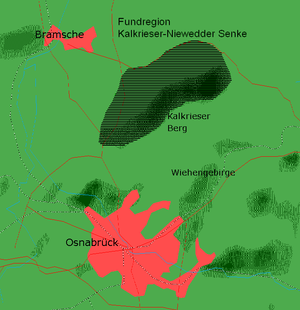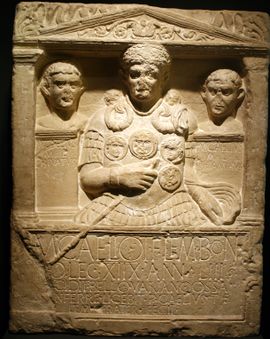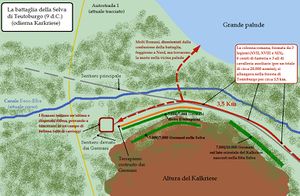معركة غابة تويتوبورگ
| ||||||||||||||||||||||||||||||
معركة غابة تويتوبورگ (ألمانية: Schlacht im Teutoburger Wald، Hermannsschlacht أو Varusschlacht)، وتوصف بأنها clades Variana (الكارثة الڤارية) من قِبل المؤرخين الرومان، نشبت في غابة تويتوبورگ في سنة 9 ميلادية، حين نصب تحالف من القبائل الجرمانية كميناً ودمّروا ثلاث فيالق رومانية بمؤازريهم بقيادة پوبليوس كوينتليوس ڤاروس. التحالف المضاد للرومان كان يقوده أرمينيوس، الذي حصل الجنسية الرومانية وتلقى تعليماً عسكرياً رومانياً، مما مكـّنه شخصياً من خداع القائد الروماني وكذلك مكـّنه من توقع الردود التكتيكية للجيش الروماني.
وبالرغم من عدة حملات وغارات ناجحة من الجيش الروماني في الأعوام التالية للمعركة، إلا أنهم لم يحاولوا منذ ذلك الحين إخضاع أرض جرمانية شرق نهر الراين. النصر الجرماني على الفيالق الرومانية في غابة تويتوبورگ كان له آثار بعيدة المدى على التاريخ اللاحق لكل من الشعوب الجرمانية و الامبراطورية الرومانية. وقد اعتبر المؤرخون المعاصرون نصر أرمينيوس "أعظم هزيمة لروما"[4] وأحد أكثر المعارك حسماً في التاريخ.[5][6][7][8][9][10]
. . . . . . . . . . . . . . . . . . . . . . . . . . . . . . . . . . . . . . . . . . . . . . . . . . . . . . . . . . . . . . . . . . . . . . . . . . . . . . . . . . . . . . . . . . . . . . . . . . . . . . . . . . . . . . . . . . . . . . . . . . . . . . . . . . . . . . . . . . . . . . . . . . . . . . . . . . . . . . . . . . . . . . . .
الخلفية

كان أرمينيوس هذا طفلا صغيرا من أبناء القبائل الجرمانية عندما إختطفه الرومان من منطقة شرق نهر الراين ونقلوه إلي روما حيث حصل علي تدريب عسكري وصل به إلي رتبة ضابط في الجيش ومساعد ومحل ثقة القائد كوينتليوس فاروس الذي كان قائدا متمرسا حارب بنجاح في الشام ونجح في معارك عديدة ولكنه كان قاسيا في أحكامه. وعندما توغل الرومان في أرض الجرمان شرق نهر الراين الذي كان يمثل حدودهم الشرقية عند أقصي إتساع كان أرمينيوس هذا معهم نائبا للقائد فاروس. وقد مارس فاروس الحكم القهري علي الجرمان فكان يحكم بالصلب والقتل والإستيلاء علي المحاصيل رغم قلتها مما جعل أرمينيوس (هرمان بالألمانية) يعكس ولاءه ويغير فكره ويقرر أن ينتقم من الجيش الروماني بأسره وكان قوامه 20 ألف جندي مقسمين علي 3 فيالق Legiones وكل ذلك تم بدون علم فاروس الذي كان يثق فيه فلم يتوخ الحرص من ناحيته.
المعارك
العواقب
وبمجرد سماعه الأخبار، شق الامبراطور أغسطس ملابسه، ورفض أن يقص شعره لشهور، ولأعوام تلت كان يُسمع وهو يقول، أنيناً في مختلف المناسبات، "كوينكتيليوس ڤاروس، أرجـِع لي فيالقي!" ("Quintili Vare, legiones redde!").
الثأر الروماني
حملة جرمانيكوس على القبائل الجرمانية
- حملات جرمانيكوس و أ. كايكينا في الأعوام 14-16 م
الحملات اللاحقة
الوقع على التوسع الروماني
From the time of the rediscovery of Roman sources in the 15th century, Teutoburg Forest has been seen as a pivotal clash, which ended Roman expansion into northern Europe. This notion became especially prevalent in the 19th century, where it formed an integral part of the mythology of German nationalism.
موقع المعركة


سياسة تربية أبناء الأعداء
وسياسة أخذ ابناء الأسري وتربيتهم في دار المنتصر هي سياسة قديمة جدا حتي أن تحتمس الثالث قد إتبعها مع أبناء خصمه حيث سحب منه أبناءه عقب معركة مجيدو وأخذهم إلي طيبة ليضمن ولاء هذا الخصم الذي لا أذكر إسمه الآن,
والدولة التي نجحت نجاحا مبهرا في ذلك هي الدولة العثمانية التي كانت تربي أبناء خصومها المسيحيين في مدارس عسكرية خاصة يتعلمون فيها الحرب والإدارة ويصبحوا من رعايا السلطان وعبيده يخدمون بعد ذلك في الدولة وأمامهم الفرصة مفتوحة حتي أعلي المناصب وهو منصب الصدر الأعظم أي ما يعادل رئيس الوزراء تحت السلطان.
حتي في أستراليا والولايات المتحدة إلي منتصف القرن العشرين كان الهنود يحرمون من أبنائهم الذين يسحبون منهم لكي تربيهم عائلات بيضاء علي القيم واللغة البيضاء إلي أن توقفت هذه الممارسة بعد الحرب العالمية الثانية.
ولكن الرومان علي ما يبدو لم ينجحوا في هذه العملية التكاملية فانشق عليهم أرمينيوس (هرمان) وأفني 3 من فرقهم عن بكرة أبيهم إلي درجة أن القيصر أغسطس كان يهتف مناديا فاروس أن يعيد إليه فرقه الهالكة، وهو الذي تلقي رأس فاروس مرشوقا علي حربة بعد أن إنتحر كرسالة من أرمينيوس تقول له لا تقرب أرضنا بعد الآن.
وبالفعل فقد تحاشي الرومان بعد ذلك أي عبور لنهر الراين وظلوا علي ضفته الغربية لا يعبرون إلي الشرقية من هول ما لاقوا في تلك الأراضي.
وقد إكتشف الألمان أثناء عداوتهم التاريخية المتوارثة مع الفرنسيين أن أرمينيوس يصلح محفزا للهمم ورمزا قوميا فأقاموا له تمثالا ضخما عند مدخل تلك الغابة Hermannsdenkmal وذلك عقب هزيمة فرنسا عام 1870 علي يد ألمانيا ووضعوا وجهه ناحية الغرب (مواجها لفرنسا) كنوع من التذكرة بالهزيمة التي لحقت باللاتين (الرومان) علي يد الجرمان.
وفي مكان قريب من هذه الموقعة جرت بعد ذلك بحوالي 800 عام موقعة أخري عكسية كان بطلها كارل الأكبر أو شارل الأكبر أو شارلمان (الذي كان يراسل هارون الرشيد الخليفة العباسي وكان حفيد شارل مارتل أو المطرقة الذي أوقف زحف المسلمين الأمويين علي فرنسا بقيادة عبد الرحمن الداخل وقتله قبل ذلك بحوالي 60 عاما في موقعة تور بواتييه أو بلاط الشهداء) وشارلمان هذا هو من أجبر القبائل الجرمانية علي إعتناق المسيحية الكاثوليكية التي كان مقر قيادتها الروحية والتي تتوج القيصر هي روما طبعا!
وجاء ذلك الإعتناق للدين المسيحي بالقوة الباطشة وبالذبح إذ أنه أمر بذبح 4500 من الساكسونيين في شمال غرب ألمانيا اليوم بنسائهم وأطفالهم حتي يرهب القلوب ويجعلها تخاف بطشه وتدخل في دينه لأنه كان يؤمن بنظرية قيصر واحد ومملكة واحدة وعقيدة واحدة وإله واحد. وكان خصمه هو فيدوكيند.
. . . . . . . . . . . . . . . . . . . . . . . . . . . . . . . . . . . . . . . . . . . . . . . . . . . . . . . . . . . . . . . . . . . . . . . . . . . . . . . . . . . . . . . . . . . . . . . . . . . . . . . . . . . . . . . . . . . . . . . . . . . . . . . . . . . . . . . . . . . . . . . . . . . . . . . . . . . . . . . . . . . . . . . .
الوطنية الألمانية

ذكرى النصر الجرماني أعيد إحياؤها بإستعادة تواريخ تاكيتوس في القرن 15، حين أصبحت شخصية أرمينيوس، الذي يُعرف الآن بإسم "هرمان" (وهو تحريف للاسم "أرمين" والذي كثيراً ما نُسِب، على وجه خاطئ، إلى مارتن لوثر)، أصبح رمزاً وطنياً للـ Pan-Germanism. ومنذ ذلك الحين، أصبحت غابة تويتوبورگ يُنظر إليها كصدام محوري أنهى التوسع الروماني في شمال أوروپا. هذا البعد، بوجه خاص، أصبح طاغياً في القرن التاسع عشر، حين شكلت جزءاً لا يتجزأ من أساطير الوطنية الألمانية.
رسوم من القرن 19
Hermannsschlacht، بريشة ولي العهد فريدرش ڤلهلم الرابع من پروسيا، 1813
Grab des Arminius (قبر أرمينيوس)، كاسپار داڤيد فريدرش، 1812
Der siegreich vordringende Hermann (التقدم المنتصر لهرمان)، پيتر يانسن, 1873
Battle of the Teutoburg Forest - Furor Teutonicus, Paja Jovanović, 1889
المصادر
المصادر القديمة
The following is a list of all known references to the battle from the literary sources of classical antiquity. Though the account provided in the Roman History is the most detailed of these, Dio Cassius' almost two-century removal from the event and his use of detail mentioned by no earlier author render it much more likely to be a literary re-imagining than a reliable historical record.[بحاجة لمصدر]
- اوڤيد, تريستيا (الأحزان), poetic verses written in 10 and 11 CE
- ماركوس مانيليوس, Astronomica, a poem written early in the 1st century CE
- اسطرابون, Geographia 7:1.4, geographically themed history, written around 18 CE
- ماركوس ڤليوس پاتركولوس, التاريخ الروماني 2:117–120, written in 30 CE
- تاكيتوس، Annals 1.3, 1.10, 1.43, 1.55–71, 2.7, 2.41, 2.45, a history written in 109 CE
- Suetonius, Lives of the Twelve Caesars: Augustus 23, Tiberius 17–18, biographies written in 121 CE
- فلوروس, Epitome de T. Livio Bellorum omnium annorum DCC Libri duo 2:30, history/panegyric, written in the early 2nd century CE
- Dio Cassius, Roman History 56:18–24, written in the first half of the 3rd century CE
- Seneca the Younger, "Epistulae Morales ad Lucilium," referenced in Letter 47, Section 10
القرن 21
- Ancient Warfare special "The Varian Disaster", June 2009 (essays by various authors, including Clunn and Murdoch)
- Fergus M. Bordewich, "The ambush that changed history" in Smithsonian Magazine, September 2005, pp. 74–81.
- Wilm Brepohl, Neue Überlegungen zur Varusschlacht. Aschendorff, Münster 2004, ISBN 3-402-03502-2 (بالألمانية) (Reconsidering the Varus Battle.)
- Cawthorne, Nigel (July 24, 2012). Battles That Changed History: An Encyclopedia of World Conflict. Arcturus Publishing. ISBN 1848589549. Retrieved January 16, 2015.
{{cite book}}: Invalid|ref=harv(help) - Tony Clunn, The Quest for the Lost Roman Legions, Savas Beatie LLC, 2005, 372 pp. ISBN 978-1-932714-70-8. The late author discovered the battlefield. This book is a combination of the account of his discovery, the artifacts he found, and his theory about the course of the battle, with that portion recounted in fictional style built around the history.
- Creasy, E. S. (July 24, 2012). The Fifteen Decisive Battles from Marathon to Waterloo. Wildside Press LLC. ISBN 1434484424. Retrieved January 16, 2015.
{{cite book}}: Invalid|ref=harv(help) - Davis, Paul K. (1999). 100 Decisive Battles: From Ancient Times to the Present. Oxford University Press. ISBN 0195143663. Retrieved January 16, 2015.
{{cite book}}: Invalid|ref=harv(help) - Boris Dreyer, Arminius und der Untergang des Varus. Warum die Germanen keine Römer wurden. Klett-Cotta, Stuttgart 2009, ISBN 978-3-608-94510-2 (بالألمانية) (Arminius and the downfall of Varus. Why the Teutons did not become Romans.)
- Durschmied, Erik (April 13, 2013). The Weather Factor: How Nature Has Changed History. Hachette UK. ISBN 1444769650. Retrieved January 16, 2015.
{{cite book}}: Invalid|ref=harv(help) - Adrian Goldsworthy, In The Name of Rome: The Men Who Won The Roman Empire. Weidenfeld & Nicolson, London, 2004.
- Joachim Harnecker, Arminius, Varus und das Schlachtfeld von Kalkriese. Eine Einführung in die archäologischen Arbeiten und ihre Ergebnisse. 2nd ed. Rasch, Bramsche 2002 ISBN 3-934005-40-3 (بالألمانية) (Arminius, Varus and the battlefield of Kalkriese. An introduction to the archaeological work and its results.)
- Ralf Günter Jahn, Der Römisch-Germanische Krieg (9–16 n. Chr.). Dissertation, Bonn 2001 (بالألمانية) (The Roman-Germanic war (9–16 CE).)
- Johann-Sebastian Kühlborn, "Auf dem Marsch in die Germania Magna. Roms Krieg gegen die Germanen". In: Martin Müller, Hans-Joahim Schalles und Norbert Zieling (Eds.), Colonia Ulpia Traiana. Xanten und sein Umland in römischer Zeit. Zabern, Mainz 2008, ISBN 978-3-8053-3953-7, S. 67–91. (بالألمانية) ("On the march into Germania Magna. Rome's war against the Germanic tribes".)
- Fabian Link, Die Zeitdetektive. Die Falle im Teutoburger Wald: Ein Krimi aus der Römerzeit. Ravensburger, 2010, ISBN 978-3-473-34535-9. (بالألمانية) (The time detectives. The events in the Teutoburg Forest: a crime story of Roman times.) (youth fiction)
- Ralf-Peter Märtin, Die Varusschlacht. Rom und die Germanen. S. Fischer Verlag, Frankfurt am Main 2008, ISBN 978-3-10-050612-2 (بالألمانية) (The Varus Battle. Rome and the Germanic tribes.)
- Günther Moosbauer, Die Varusschlacht. Beck'sche Reihe, Verlag C. H. Beck Wissen, München 2009, ISBN 978-3-406-56257-0 (بالألمانية) (The Varus Battle.)
- Murdoch, Adrian (1 December 2012). Rome's Greatest Defeat: Massacre in the Teutoburg Forest. The History Press. ISBN 0752494554. Retrieved January 16, 2015.
{{cite book}}: Invalid|ref=harv(help) - Paweł Rochala, Las Teutoburski 9 rok n.e. (Polish) Bellona, Warszawa, 2005.
- Michael Sommer, Die Arminiusschlacht. Spurensuche im Teutoburger Wald. Stuttgart 2009 (بالألمانية) (The Arminius Battle. Search for traces in the Teutoburg Forest.)
- Dieter Timpe, Römisch-germanische Begegnung in der späten Republik und frühen Kaiserzeit. Voraussetzungen – Konfrontationen – Wirkungen. Gesammelte Studien. Saur, München & Leipzig, 2006, ISBN 3-598-77845-7 (بالألمانية) (Roman-Germanic encounter in the late Republic and early Empire. Conditions – Confrontations – Effects. Collected Studies.)
- Tucker, Spencer (2010). Battles That Changed History: An Encyclopedia of World Conflict. ABC-CLIO. ISBN 1598844296. Retrieved January 16, 2015.
{{cite book}}: Invalid|ref=harv(help) - Peter S. Wells, The Battle That Stopped Rome: Emperor Augustus, Arminius, and the Slaughter of the Legions in the Teutoburg Forest, W.W. Norton & Company, New York, NY 2003, ISBN 0-393-02028-2 Strong on archaeology; controversial[بحاجة لمصدر] "Florus"-based theory.
- Peter Oppitz, Das Geheimnis der Varusschlacht. Zadara-Verlag, 2006, ISBN 3-00-019973-X (بالألمانية) (The mystery of the Varus Battle.) Paderborn would have been the site of the battle.
- Rainer Wiegels (ed.), Die Varusschlacht. Wendepunkt der Geschichte? Theiss, Stuttgart 2007, ISBN 978-3-8062-1760-5 (بالألمانية) (The Varus Battle. Turning point of history?)
- Reinhard Wolters, Die Römer in Germanien. 5th ed. Verlag C.H. Beck, München 2006, ISBN 3-406-44736-8 (بالألمانية) (The Romans in Germania.)
- Reinhard Wolters, Die Schlacht im Teutoburger Wald. Arminius, Varus und das römische Germanien. München 2008, ISBN 978-3-406-57674-4 (بالألمانية) (The Battle of the Teutoburg Forest. Arminius, Varus and Roman Germania.)
. . . . . . . . . . . . . . . . . . . . . . . . . . . . . . . . . . . . . . . . . . . . . . . . . . . . . . . . . . . . . . . . . . . . . . . . . . . . . . . . . . . . . . . . . . . . . . . . . . . . . . . . . . . . . . . . . . . . . . . . . . . . . . . . . . . . . . . . . . . . . . . . . . . . . . . . . . . . . . . . . . . . . . . .
القرن العشرون
- Gesa von Essen, Hermannsschlachten. Germanen- und Römerbilder in der Literatur des 18. und 19. Jahrhunderts. Wallstein Verlag, Göttingen 1998, ISBN 3-89244-312-2 (بالألمانية) (Hermann Battles. Images of Teutons and Romans in the literature of the 18th and 19th centuries.)
- Wolfgang Schlüter (Ed.), Römer im Osnabrücker Land. Die archäologischen Untersuchungen in der Kalkrieser-Niewedder Senke. Rasch, Bramsche 1991, ISBN 3-922469-57-4 (بالألمانية) (Romans in the Osnabrück District. The archaeological excavations in the Kalkriese-Niewedde depression.)
القرن 19
- Edward Shepherd Creasy, Germans under Arminius Revolt Against Rome in The Great Events by Famous Historians, Vol. 2, compilation of historical essays published in 1905
انظر أيضاً
الهامش
- ^ "Marcus Caelius". www.livius.org. September 2010.
- ^ Wells, Peter S. The Battle that stopped Rome. New York: W.W. Norton & Company. 2003, p. 187 ISBN 0-393-32643-8
- ^ Kevin Sweeney, Scholars look at factors surrounding Hermann’s victory. www.nujournal.com
- ^ Murdoch 2012
- ^ Tucker 2010, p. 75
- ^ Cawthorne 2012
- ^ Durschmied 2013
- ^ Davis 1999, p. 68
- ^ Creasy 2007, p. 104
- ^ "How the eagles were tamed". The Spectator. March 27, 2004. Retrieved January 16, 2015.
مومزن referred to the Battle of the Teutoburg forest as a turning-point in world history.
- ^ Wolfgang Schlüter: Zwischen Lutherdamm und Oberesch – Die Anfänge des Kalkriese-Projektes. In: Varus-Gesellschaft (Ed.): Varus-Kurier. Georgsmarienhütte, April 2002. pp. 7 ff. (بالألمانية)
وصلات خارجية
- Fergus M. Bordewich: "The Ambush That Changed History" Smithsonian Magazine, September 2005
- Official site of the Kalkriese foundation
- Jona Lendering, The Battle in the Teutoburg Forest at livius.org
- Arminius / Varus. Die Varusschlacht im Jahre 9 n. Chr., Internet-Portal „Westfälische Geschichte“, LWL-Institut für westfälische Regionalgeschichte, Münster (بالألمانية)
- Student project site by Universität Osnabrück (بالألمانية)
- Varusbattle in Netherland (بالألمانية)
52°24′29″N 8°07′46″E / 52.40806°N 8.12944°E
خطأ لوا في وحدة:Authority_control على السطر 278: attempt to call field '_showMessage' (a nil value).
- Pages using gadget WikiMiniAtlas
- Articles containing ألمانية-language text
- Pages using Lang-xx templates
- Articles with hatnote templates targeting a nonexistent page
- Articles with unsourced statements from December 2013
- Articles with unsourced statements from March 2008
- Pages with empty portal template
- Coordinates on Wikidata
- معركة غابة تويتوبورگ
- 9 في الامبراطورية الرومانية
- نزاعات القرن الأول
- معارك الامبراطورية الرومانية
- الوثنية الجرمانية
- تاريخ الشعوب الجرمانية
- التاريخ العسكري لألمانيا
- Wiehen Hills
- معارك الشعوب الجرمانية
- القرن الأول في الامبراطورية الرومانية

















